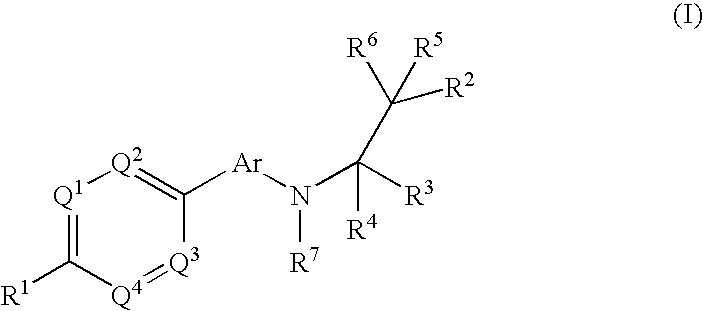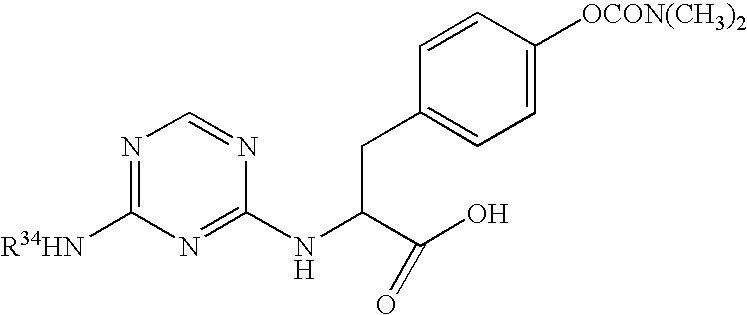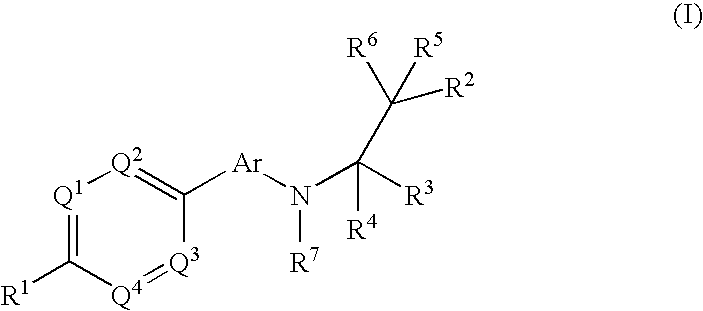Phenyl or heteroaryl amino alkane derivatives as ip receptor antagonist
a technology of ip receptor, which is applied in the direction of drug compositions, immune disorders, extracellular fluid disorders, etc., can solve the problems of inducing symptoms of overactive bladder, no reference and other reference disclose phenyl or heteroaryl amino alkane derivatives, etc., and achieve excellent ip receptor antagonistic activity.
- Summary
- Abstract
- Description
- Claims
- Application Information
AI Technical Summary
Benefits of technology
Problems solved by technology
Method used
Image
Examples
example 1-1
Methyl N-(6-chloropyrimidin-4-yl)-D-phenylalaninate
[0431]
[0432] To a mixture of 4,6-dichloropyrimidine (57 g, 383 mmol), D-phenylalanine methyl ester hydrochloride (75 g, 348 mmol) and 1,4-dioxane (440 mL) was added N,N-diisopropylethylamine (123 mL, 730 mmol), and the mixture was stirred at 80° C. overnight. After cooled to room temperature, the mixture was concentrated under reduced pressure, and the residue was partitioned between ethyl acetate and water. The separated organic phase was washed with brine, dried over sodium sulfate, filtered and concentrated under reduced pressure. The crude product was purified by column chromatography on silica-gel (hexane:ethyl acetate, 3:1) to give methyl N-(6-chloropyrimidin-4-yl)-D-phenylalaninate (99.3 g, 98%) as a brown oil.
Methyl N-{6-[4-(benzyloxy)phenyl] pyrimidin-4-yl}-D-phenylalaninate
[0433]
[0434] To a mixture of methyl N-(6-chloropyrimidin-4-yl)-D-phenylalaninate (30.0 g, 103 mmol), 4-benzyloxy)phenylboronic acid (28.1 g, 123 mmol...
example 1-2
Methyl N-{6-[4-(cyclopropylmethoxy)phenyl] pyrimidin-4-yl}-D-phenylalaninate
[0443]
[0444] To a mixture of methyl N-(6-chloropyrimidin-4-yl)-D-phenylalaninate (1.27 g, 4.34 mmol), 4-(cyclopropylmethoxy)phenylboronic acid [starting compound 1A] (1.0 g, 5.21 mmol) and benzene (8.7 mL) under an argon atmosphere was added potassium carbonate (1.2 g, 8.68 mmol) followed by tetrakis(triphenylphosphine)palladium (0.25 g, 0.22 mmol). The mixture was stirred at reflux overnight. After cooled to room temperature, the mixture was filtered through a pad of celite and the filterate was partitioned between ethyl acetate and water. The separated organic phase was washed with brine, dried over sodium sulfate, filtered and concentrated under reduced pressure. The crude product was purified by column chromatography on silica-gel (hexane:ethyl acetate, 8:2) to give methyl N-{6-[4-(cyclopropylmethoxy)phenyl] pyrimidin-4-yl}-D-phenylalaninate (1.05 g, 60%) as a pale yelow oil.
N-{6-[4-(Cyclopropylmethoxy...
example 1-3
Ethyl D-norleucinate hydrochloride
[0454]
[0455] A solution of D-norleucine (15.0 g, 114 mmol) in ethanol (300 mL) was cooled to −70° C., and thionyl chloride (25.0 mL, 343 mmol) was added dropwise over 30 minutes. The mixture was heated under reflux overnight. After cooled to room temperature, the mixture was concentrated under reduced pressure to give ethyl D-norleucinate hydrochloride (22.2 g, quant.) as a colorless solid.
Ethyl N-(6-chloropyrimidin-4-yl)-D-norleucinate
[0456]
[0457] To a mixture of 4,6-dichloropyrimidine (15.0 g, 101 mmol) and ethyl D-norleucinate hydrochloride (21.7 g, 111 mmol) in dioxane (440 mL) was added dropwise N,N′-diisopropylethylamine (38.6 mL, 222 mmol). The mixture was stirred at 65° C. overnight, and then at 80° C. for 4 hours. After cooled to room temperature, the mixture was evaporated under reduced pressure. The residue was diluted with water, and the mixture was extracted with ethyl acetate. The separated organic layer was washed with brine, dried...
PUM
| Property | Measurement | Unit |
|---|---|---|
| temperature | aaaaa | aaaaa |
| temperature | aaaaa | aaaaa |
| temperature | aaaaa | aaaaa |
Abstract
Description
Claims
Application Information
 Login to View More
Login to View More - R&D
- Intellectual Property
- Life Sciences
- Materials
- Tech Scout
- Unparalleled Data Quality
- Higher Quality Content
- 60% Fewer Hallucinations
Browse by: Latest US Patents, China's latest patents, Technical Efficacy Thesaurus, Application Domain, Technology Topic, Popular Technical Reports.
© 2025 PatSnap. All rights reserved.Legal|Privacy policy|Modern Slavery Act Transparency Statement|Sitemap|About US| Contact US: help@patsnap.com



